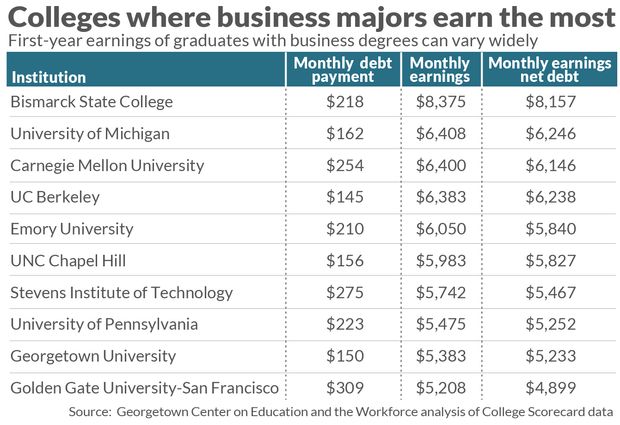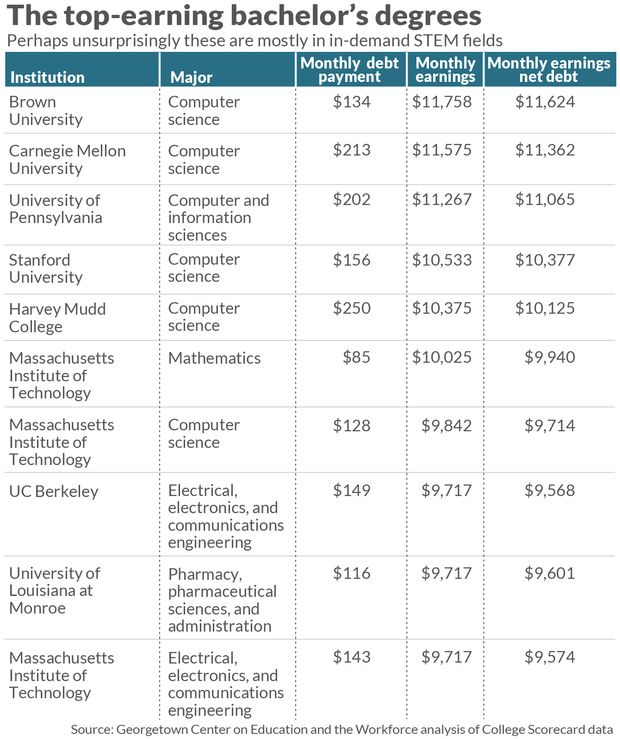
Earnings for college graduates can vary widely by major and school. (Photo by Robyn Beck / AFP)ROBYN BECK/AFP/Getty Images
robyn beck/Agence France-Presse/Getty Images
The shift to remote learning or, in some cases, a scaled back in-person experience at colleges and universities amid the coronavirus pandemic, has put a renewed focus on a question students and families have long asked about college education:
What is the value I’ll glean from my degree?
New research from Georgetown University’s Center for Education and the Workforce finds that it depends, but not necessarily on the factors one might expect. Degrees from the most prestigious colleges don’t always deliver the biggest paychecks after graduation.
The bachelor’s degree in business operations, administration or management with the highest median first-year earnings was Bismarck State College’s bachelor of applied science in energy management in Bismarck, N.D. Students earn more than $100,000 a year on average in their first year following graduation.
Despite its earnings potential, the degree likely isn’t for most students. It’s designed for workers already working in the energy industry — which could explain the relatively high earnings, in part — who want to climb the career ladder, according to the school’s website. To be eligible for the program, students need an associate’s degree in applied science or an approved certificate or diploma in a related field.

In some cases, shorter programs can deliver more to students earnings-wise in their first year following graduation than others that may require a larger time or money investment.
For example, students who earn an associate’s degree in nursing from the City University of New York earn $5,017 per month in their first year following graduation — $800 higher than the median monthly earnings of graduates of all schools with master’s degrees.

Lawmakers could soon consider a revamp of higher education
The Georgetown analysis, published Wednesday, comes after years of concern from families over whether college is delivering a return on their significant investment. But what makes the data on which the center’s analysis relies — a government trove known as The College Scorecard — “important and useful,” is that it comes as lawmakers are likely to consider a revamp of our higher education system, said Anthony Carnevale, the director of the Georgetown Center.
Former Vice President Joe Biden is proposing to make public college free for students from families earning $125,000 or less — an effort that would likely demand increased transparency from colleges on how well schools are delivering on the government’s investment. But even if Biden doesn’t win, Carnevale said he expects Congressional Republicans will push for colleges to become less opaque. More than a dozen Republican lawmakers have already expressed support for a bill that would create a more robust system of data on college outcomes.
“It’s our workforce development system and it’s expensive,” Carnevale said of higher education. “The public wants it cheaper, better, faster and it’s never going to get that way until institutions compete at the program level.”
The College Scorecard, which began releasing major-level data last year, is the beginning of allowing for that kind of competition, Carnevale said. “We’re about to create a market, but it’s been painfully slow,” he said. Though the government is providing this information, he’s not sure it will reach prospective students unless lawmakers mandate that colleges provide it to them, Carnevale said.
First-year earnings for business degrees range from $20,000 to $100,000
The Center’s analysis of the data provides insights that could influence prospective students, depending on their interests. For example, the researchers found that first-year median earnings for students graduating with an bachelor’s degree in business administration can range from less than $20,000 to more than $100,000.
Broadly, nearly 40% of prime age workers who earn between $100,001 and $200,000 have a bachelor’s degree, while only 23% have a master’s degree. Roughly 18% of graduates earning that much annually graduated with an associate’s degree.
Shorter degree programs don’t necessarily mean less debt. Among those graduates paying between $301 and $400 per month in student loans, 43% earned a master’s degree, the researchers found — about the same share who earned only a bachelor’s degree. Eleven percent forking over that sum each month earned an associate’s degree.
Students are increasingly focused on return on investment
The focus on return on investment of degrees over the past several years has had consequences on students’ choices and on colleges’ approach to education. As science, technology, engineering and math, or STEM, degrees have become lauded over the past several years for their ability to train students for in-demand jobs, liberal arts majors have become increasingly a dying breed — even as employers seek workers with the skills that a humanities background can provide.
At the same time, colleges faced with funding challenges have, in some cases, moved to cut liberal arts majors in favor of STEM disciplines.
The complex dynamic between interest, earnings, and level of schooling is why Carnevale said he believes any higher education revamp should include career counseling as early as high school.
“It’s a complicated set of relationships,” he said. Just because some associate’s degrees or certificates provide higher earnings than some bachelor’s degrees, doesn’t necessarily mean it makes sense for a student to pursue them in the long-run, he said.
For example, while graduates with bachelor’s degrees may be earning less than their counterparts with associate’s degrees or technical certificates in their first 10 years out of school, that dynamic usually shifts after both are twenty years out of school, he said.
“In any field of study where there is that hierarchy you want to follow that hierarchy as far as you can, because the gain is about getting the richest mix of specific and general education that you can,” he said.




